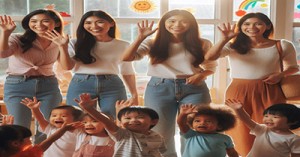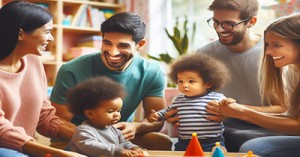The following lists the sub outcomes, examples of evidence when children can achieve each sub outcome and how educators can promote and help children to achieve EYLF Learning Outcome 5: Children Are Effective Communicators.
Experiences in early childhood settings build on the range of experiences with language, literacy and numeracy that children have within their families and communities. Positive attitudes and competencies in literacy and numeracy are essential for children’s successful learning. The foundations for these competencies are built in early childhood.
Learning Outcome 5: Children Are Effective Communicators
5.1 Children interact verbally and non-verbally with others for a range of purposes.
This is evident when children:
- engage in enjoyable interactions using verbal and non-verbal language.
- convey and construct messages with purpose and confidence, building on home/family and community literacies.
- respond verbally and non-verbally to what they see, hear, touch, feel and taste.
- use language and representations from play, music and art to share and project meaning.
- contribute their ideas and experiences in play, small and large group discussions.
- attend and give cultural cues that they are listening to and understanding what is said to them.
- are independent communicators who initiate Standard Australian English and home language conversations and demonstrate the ability to meet the listeners’ needs.
- interact with others to explore ideas and concepts, clarify and challenge thinking, negotiate and share new understandings.
- convey and construct messages with purpose and confidence, building on literacies of home/family and the broader community.
- exchange ideas, feelings and understandings using language and representations in play.
- demonstrate an increasing understanding of measurement and number using vocabulary to describe size, length, volume, capacity and names of numbers.
- express ideas and feelings and understand and respect the perspectives of others.
- use language to communicate thinking about quantities to describe attributes of objects and collections, and to explain mathematical Ideas.
- show increasing knowledge, understanding and skill in conveying meaning in at least one language.
Educators promote this learning by:
- engage in enjoyable interactions with babies as they make and play with sounds.
- are attuned and respond sensitively and appropriately to children’s efforts to communicate.
- listen to and respond to children’s approximations of words.
- value children’s linguistic heritage and with family and community members encourage the use of and acquisition of
- home languages and Standard Australian English.
- recognize that children enter early childhood programs have begun to communicate and make sense of their
- experiences at home and in their communities.
- model language and encourage children to express themselves through language in a range of contexts and for a range of purposes.
- engage in sustained communication with children about ideas and experiences, and extend their vocabulary.
- include real-life resources to promote children’s use of mathematical language.
5.2 Children engage with a range of texts and gain meaning from these texts.
This is evident when children:
- listen and respond to sounds and patterns in speech, stories and rhymes in context.
- view and listen to printed, visual and multimedia texts and respond with relevant gestures, actions, comments and/or questions.
- sing and chant rhymes, jingles and songs.
- take on roles of literacy and numeracy users in their play.
- begin to understand key literacy and numeracy concepts and processes, such as the sounds of language, letter-sound relationships, concepts of print and the ways that texts are structured.
- explore texts from a range of different perspectives and begin to analyze the meanings.
- actively use, engage with and share the enjoyment of language and texts in a range of ways.
- recognize and engage with written and oral culturally constructed texts.
Educators promote this learning by:
- read and share a range of books and other texts with children.
- provide a literacy-enriched environment including display print in home languages and Standard Australian English.
- sing and chant rhymes, jingles and songs.
- engage children in play with words and Sounds.
- talk explicitly about concepts such as rhyme and letters and sounds when sharing texts with children.
- incorporate familiar family and community texts and tell stories.
- join in children’s play and engage children in conversations about the meanings of images and print.
- engage children in discussions about books and other texts that promote consideration of diverse perspectives.
- support children to analyze ways in which texts are constructed to present particular views and to sell products.
- teach art as language and how artists can use the elements and principles to construct visual/musical/dance/media texts.
- provide opportunities for children to engage with familiar and unfamiliar culturally constructed text.
5.3 Children express ideas and make meaning using a range of media.
This is evident when children:
- use language and engage in play to imagine and create roles, scripts and ideas.
- share the stories and symbols of their own culture and re-enact well-known stories.
- use the creative arts such as drawing, painting, sculpture, drama, dance, movement, music and storytelling to express ideas and make meaning.
- experiment with ways of expressing ideas and meaning using a range of media.
- begin to use images and approximations of letters and words to convey meaning.
Educators promote this learning by:
- build on children’s family and community experiences with creative and expressive arts.
- provide a range of resources that enable children to express meaning using visual arts, dance, drama and music.
- ask and answer questions during the reading or discussion of books and other texts.
- provide resources that encourage children to experiment with images and print.
- teach children skills and techniques that will enhance their capacity for self-expression and communication.
- join in children’s play and co-construct materials such as signs that extend the play and enhance literacy learning.
- respond to children’s images and symbols, talking about the elements, principles, skills and techniques they have used in order to convey meaning.
5.4 Children begin to understand how symbols and pattern systems work.
This is evident when children:
- use symbols in play to represent and make meaning.
- begin to make connections between and see patterns in their feelings, ideas, words and actions and those of others.
- notice and predict the patterns of regular routines and the passing of time.
- develop an understanding that symbols are a powerful means of communication and that ideas, thoughts and concepts can be represented through them.
- begin to be aware of the relationships between oral, written and visual representations.
- begin to recognize patterns and relationships and the connections between them.
- begin to sort, categorize, order and compare collections and events and attributes of objects and materials, in their social and natural worlds.
- listen and respond to sounds and patterns in speech, stories and rhyme.
- draw on memory of a sequence to complete a task.
- draw on their experiences in constructing meaning using symbols.
Educators promote this learning by:
- draw children’s attention to symbols and patterns in their environment and talk about patterns and relationships, including the relationship between letters and sounds.
- provide children with access to a wide range of everyday materials that they can use to create patterns and to sort, categorize, order and compare.
- engage children in discussions about symbol systems, for example, letters, numbers, time, money and musical notation.
- encourage children to develop their own symbol systems and provide them with opportunities to explore culturally constructed symbol systems.
5.5 Children use information and communication technologies to access information, investigate ideas and represent their thinking.
This is evident when children:
- identify the uses of technologies in everyday life and use real or imaginary technologies as props in their play.
- use information and communication technologies to access images and information, explore diverse perspectives and make sense of their world.
- use information and communication technologies as tools for designing, drawing, editing, reflecting and composing.
- engage with technology for fun and to make meaning.
Educators promote this learning by:
- provide children with access to a range of technologies.
- integrate technologies into children’s play experiences and projects.
- teach skills and techniques and encourage children to use technologies to explore new information and represent their ideas.
- encourage collaborative learning about and through technologies between children, and children and educators.
References:
Understanding EYLF Outcomes, Aussie Childcare Network
EYLF Learning Outcomes, Aussie Childcare Network
How Children Can Achieve Outcomes, Aussie Childcare Network
How Educators Can Promote Outcomes, Aussie Childcare Network







 Here is the list of the EYLF Learning Outcomes that you can use as a guide or reference for your documentation and planning. The EYLF
Here is the list of the EYLF Learning Outcomes that you can use as a guide or reference for your documentation and planning. The EYLF The EYLF is a guide which consists of Principles, Practices and 5 main Learning Outcomes along with each of their sub outcomes, based on identity,
The EYLF is a guide which consists of Principles, Practices and 5 main Learning Outcomes along with each of their sub outcomes, based on identity, This is a guide on How to Write a Learning Story. It provides information on What Is A Learning Story, Writing A Learning Story, Sample
This is a guide on How to Write a Learning Story. It provides information on What Is A Learning Story, Writing A Learning Story, Sample One of the most important types of documentation methods that educators needs to be familiar with are “observations”. Observations are crucial for all early childhood
One of the most important types of documentation methods that educators needs to be familiar with are “observations”. Observations are crucial for all early childhood To support children achieve learning outcomes from the EYLF Framework, the following list gives educators examples of how to promote children's learning in each individual
To support children achieve learning outcomes from the EYLF Framework, the following list gives educators examples of how to promote children's learning in each individual Reflective practice is learning from everyday situations and issues and concerns that arise which form part of our daily routine while working in an early
Reflective practice is learning from everyday situations and issues and concerns that arise which form part of our daily routine while working in an early Within Australia, Programming and Planning is reflected and supported by the Early Years Learning Framework. Educators within early childhood settings, use the EYLF to guide
Within Australia, Programming and Planning is reflected and supported by the Early Years Learning Framework. Educators within early childhood settings, use the EYLF to guide When observing children, it's important that we use a range of different observation methods from running records, learning stories to photographs and work samples. Using
When observing children, it's important that we use a range of different observation methods from running records, learning stories to photographs and work samples. Using This is a guide for educators on what to observe under each sub learning outcome from the EYLF Framework, when a child is engaged in
This is a guide for educators on what to observe under each sub learning outcome from the EYLF Framework, when a child is engaged in The Early Years Learning Framework describes the curriculum as “all the interactions, experiences, activities, routines and events, planned and unplanned, that occur in an environment
The Early Years Learning Framework describes the curriculum as “all the interactions, experiences, activities, routines and events, planned and unplanned, that occur in an environment


